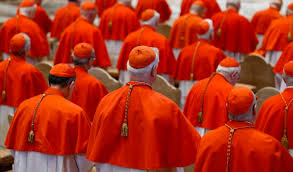CATHOLIC Church Cardinals on Wednesday, May 7, moved into the Conclave at the Vatican to elect a new Pope to succeed Pope Francis, who died on Easter Monday, April 21, after suffering from a stroke, coma and heart failure.
The 133 Cardinal electors, spread across 71 countries, would perform the sacred assignment of picking the leader of the 1.4 billion Catholics worldwide and the head of state of the Vatican, with Nigeria’s Peter Okpaleke, the Bishop of Ekwulobia, Anambra State, being the only one of the four Nigerian candidates qualified to participate in the process.
The late Pope Francis appointed 80 per cent of the 133 elector-Cardinals.
A major issue confronting the electors is whether the new Pope should be a progressive and continue the way Francis ran the church, or a conservative, who could reverse the order, or even a centrist.
The countries with the most electors are Italy (17), the United States (10), Brazil (seven), France and Spain (five each), Argentina, Canada, India, Poland and Portugal (four apiece).
Only Cardinals under the age of 80 are eligible to vote in a Conclave. The Cardinal electors proceed to the Sistine Chapel and take an oath of absolute secrecy. Thereafter the doors are sealed.
The Cardinals vote by secret ballot, processing one by one up to Michelangelo’s fresco of the Last judgment, saying a prayer and dropping the twice-folded ballot in a large chalice.
Four rounds of balloting are taken every day until a candidate receives two-thirds of the vote.
The result of each ballot are counted aloud and recorded by three Cardinals designated as recorders.
If no one receives the necessary two-thirds of the vote, the ballots are burned in a stove near the Chapel with a mixture of chemicals to produce black smoke.
When a Cardinal receives the necessary two-thirds vote, the dean of the College of Cardinals asks him if he accepts his election. If he accepts, he chooses a papal name and is dressed in papal vestments before processing out to the balcony of St. Peter’s Basilica.
The ballots of the final round are burned with chemicals producing white smoke to signal to the world the election of a new pope.
The senior Cardinal deacon, currently French Cardinal Dominique Mamberti, Prefect of the Supreme Tribunal of the Apostolic Signatura, announces from the balcony of St. Peter’s “Habemus Papam” (“We have a pope”) before the new pope processes out and imparts his blessing on the city of Rome and the entire world.
On Monday, May 5, workers installed curtains on the balcony where the new Pontiff will appear. A temporary chimney is in place on the roof of the Sistine Chapel, where Cardinals will cast secret ballots.
White smoke will eventually signal the election of the next leader for the world’s Catholics.
Over 179 Cardinals are in Rome, participating in the 10th general congregation.
Nigeria’s Okpaleke was appointed a Cardinal by Francis in 2022. His earlier appointment as Bishop of Ahiara Diocese was met with resistance, but was eventually installed as Bishop of Ekwulobia.
The three other Nigerian Cardinals, Francis Arinze (92), Anthony Olubunmi Okogie (88) and John Onaiyekan (81) have no vote, being over 80 years old.
As the Conclave began, four names have emerged as top contenders to become the new Pope, according to AP, including “Pietro Parolin, who will oversee the conclave; Luis Tagle, dubbed the ‘Asian Francis;’ Fridolin Ambongo Besungu, a conservative Cardinal native to the Congo, and Pierbattista Pizzaballa, who could be the first Italian Pope in decades.”
According to Vatican News, from the Mass for the Election of the new pope to the white smoke, Vatican Media provides broadcasts, platforms and frequencies to follow the Conclave Live via video and audio.
Already, Vatican Media had been mobilised to cover each phase moment by moment, accompanied by in-depth reports.
The first event covered was the Missa pro eligendo Romano Pontifice, which began at 10a.m. on May 7, in St. Peter’s Basilica and was broadcast in 11 languages- Italian, English, French, Spanish, Portuguese, Brazilian Portuguese, German, Polish, Chinese, Arabic and Vietnamese, and in Spanish sign language.
The Liturgy was also broadcast in shortwave radio in English, French and Portuguese to Africa.
At 4:30p.m., the entry of the Cardinal electors into the Conclave took place, along with their oath-taking ceremony before the Extra omnes, the moment when the doors of the Sistine Chapel were closed to begin the voting.
This ceremony was also covered live in 11 languages, in addition to sign language in English, Spanish and Italian, with Vatican Media providing video and photo coverage of both events.
The “Live” Wait
BEGINNING on the afternoon of May 7, anticipation mounted for the white smoke, which signals the election of the new pope.
Vatican News and Vatican Radio provide daily live coverage of the Conclave proceedings, both via video (on YouTube) and audio in seven languages- Italian, English, French, Spanish, Brazilian Portuguese and Polish.
The reports will document the results of the votes and the resulting smoke signals, which will appear at the end of the morning and the end of the day if black, or also in mid-morning or mid-afternoon if white smoke rises from the Sistine Chapel chimney.
Following the decisive white smoke, live reporting will expand from seven to 12 languages, with the addition of commentary in Arabic and Vietnamese, as well as sign language interpretation in Italian, French and Spanish.
In addition, from the moment the white smoke appears, the key moments leading up to the announcement of the new pope will also be broadcast live on Facebook in 10 languages.
L’Osservatore Romano will publish a special edition immediately after the white smoke, which will be distributed for free in St. Peter’s Square.
Overall, editorial coverage, across both written and spoken formats, including live reporting and in-depth analysis, will span 56 languages, the same languages that make up the information system of Vatican Radio, Vatican News and L’Osservatore Romano.

Published:


